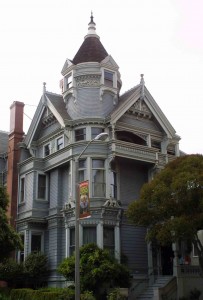
The National Zoo’s new recycling containers remind you how much energy recycling one aluminum can will save.
Do you remember when you didn’t recycle your aluminum cans, your newspapers, your cardboard? I know for me it was probably about 10 years ago when I was still living in Manhattan and there was a lot of discussion regarding the cost of recycling to the city. I will walk two blocks to find a recycling container, but I know there are still some people who don’t think about it. I took a walk around my DC neighborhood the other day and wandered over to the National Zoo, where I was delighted to see their new waste and recycling bins. When I showed these cans to a class I was teaching in Charleston last week, one participant commented “You can watch the entire Super Bowl with the energy saved from recycling one aluminum can!” We all laughed, but that was both a sobering and encouraging thought.
Recycling Buildings
At the National Trust for Historic Preservation, where I was the chief architect for five years and worked closely on the development of our sustainability program, policies and messaging, we would start our sustainability presentations with a slide that shows if we demolished our headquarters building at Dupont Circle, that would negate the benefits of recycling 78 million aluminum cans. And imagine how many Super Bowls could be watched too! The operations of buildings account for almost 50% of all greenhouse gas emissions (when you include construction and demolition activities that number is over 50%), thus it makes sense that recycling and reusing our buildings is the ultimate act of recycling. More and more people are getting that. They realize if you reuse what you have, you avoid the impacts of building new (transportation, development and harvesting of new materials and products, etc.), but still not enough people and organizations proclaim this fact as should. Fortunately, organizations like USGBC who created and manages LEED, and GSA who was the first federal agency to adopt LEED, acknowledge the significance of existing buildings on climate change and are working hard to integrate more existing building metrics into the next version of LEED (whose 2nd public draft should be out on the street later this week)**. Two new pilot credits that focus on existing and historic buildings are being evaluated for the next version – Pilot Credit 1, Life Cycle Assessment of Building Assemblies and Pilot Credit 19, Whole Building Reuse.
Coming up this summer

More and more historic buildings like the Haas-Lilienthal House owned by San Francisco Architectural Heritage are evaluating LEED certification to assist in improving their efficiency.
When the next draft of LEED comes out for public comment this summer, I will continue assisting the National Trust and other organizations in evaluating the changes. Look for comments and instructions for posting comments on the USGBC website on this blog and the National Trust’s blog. Most of us want to change our actions so we can help save our planet. Some organizations like San Francisco Architectural Heritage have made improving the “greenness” of their historic building a goal of the organization. They are working on a sustainability management plan for their historic Haas-Lilienthal house and seeking to certify their house museum under LEED. And at the SUNY at Buffalo, two historic buildings that comprise the architecture and planning school are being rehabilitated to LEED Platinum standards.
It’s much easier to recycle your soda can and water bottle than it is to recycle an entire building. I get that. But I also get that most people and organizations will do more and do better if they have the tools to help them make those decisions. There are more tools like LEED and Green Seal than ever before. You just need to go the extra step to seek them out and look for the experts to help you. And remember,“Greening what’s already here” is the best place to start.
**As of June 30th, the launching of the Next Version of LEED’s 2nd public comment period has been pushed back to July 15th.
And if you’d like to “subscribe” or follow this blog, True Green Cities, please sign up through the “Subscribe” button at the bottom left of this page. You’ll receive a daily recap when new blogs are posted.
